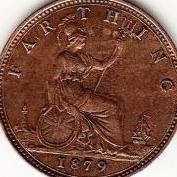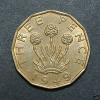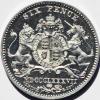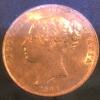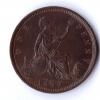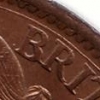Leaderboard
Popular Content
Showing content with the highest reputation on 03/23/2019 in all areas
-
5 points
-
4 points
-
One thats a bit different (daft ) that i bought last week. A couple of other different types have been touted about recently but only wanted one 😉3 points
-
I think so little research had been done at that time, that a decently rendered copy would pass without a second glance. It isn't until someone does the research that these things come to light. There is probably also a certain reluctance to accuse someone in the flesh of copying things, even if they are known to be bad. e.g. Everyone knew Taylor was producing his coins from Soho dies, and the numismatic aristocracy looked down on them, but unless someone is acting illegally there is nothing to be done - so people generally keep quiet. I'm not exactly overrun with late 18th century catalogues, but the Tyssen sale in 1802 had nothing resembling the description. There was one lot describing the coin as being in imitation of a York half crown with the lion grasping the shield (lot 2073) which sold for a guinea. It was probably either a later Chester, or a corresponding W/SA piece. I wouldn't be surprised if they were made at around the same time as the 'Colchester' pieces. You have to bear in mind that some of these issues were extremely rare 200 years ago. e.g. the Pocklington Hoard was the original source for the vast majority of York Besly type 3 halfcrowns now extant.1 point
-
I've just looked at the Ebay list- hilarious. This bubble must burst horribly soon, and when it does there will be blood on the streets. Well, metaphoric blood anyway. Or something. The Chinese fakers must be falling about laughing. We need someone to stand up and speak out against this greedy nonsense. If only Boris Johnson were alive.1 point
-
The earliest I have in the database is Lockett 2365, which has a provenance of Murdoch, Webb, Neck and Murchison. That takes it back to the 1860s, but the Hunterian example will take it back further to the end of the 18th century. Snelling doesn't mention anything about debased issues, but the provincial coins are still a bit of a mystery at this time, with some W/SA coins attributed to York on stylistic grounds alongside the unambiguous EBOR signed pieces.1 point
-
Besley suggests they may have been made for collectors. I can’t see anyone buying them as York mint issues as they are of dubious origin as stated earlier. There are examples in the BM and Hunterian. They do have a place in the York issue series. Spink lists them as typ.4.1 point
-
September 2009 Jon, so not that far off 10 years ago. £500 was a bit OTT for that one. I like the way they describe it as "buckled", like a bike wheel......or is it merely "out of true"?1 point
-
1 point
-
Only the second one I've seen where the top of the ear is still intact (the other being the far superior one Terry found), although no doubt there are plenty I haven't seen. Chuffed to bits, and the seller included a free halfpenny too.1 point
-
I don't think that's the case at all. Many respondents on forums will split the quote in a long post, into a series of smaller quotes, so they can address the various points individually. I've done the same myself on other forums. The problem on this forum is that the entire quote is boxed. So you have to go into the quote itself to respond to the separate points individually. Hence Chris was making his response in a different colour to distinguish between quote and response.1 point
-
That's looking suspiciously like a 164A - very neat capture, Jon. Well played that man. Better than average specimen as well1 point
-
But our discharge of the ‘Sick man of Europe’ tag was very little to do with membership of the EEC and everything to do with nearly two decades of Conservative government under Mrs T and Major, following a decade of largely inept government (of both colours) which allowed unregulated and strongly left wing unions to cause disruption throughout manufacturing and other industries in their efforts to prevent modernisation and efficiency savings which might just have allowed said industries to remain competitive. As a result we lost most to other countries which had modernised. It certainly took over a decade for the country to re-focus, primarily on the service sector where we are now. And I can remember inflation peaking at 15% in 1992, after nearly 20 years of membership, during the ERM debacle when the main though not only factor that triggered the instability with regard to the agreed parameters was high German interest rates caused by the costs of German reunification . Britain was not the only country affected, and 10 months later European monetary policy rules were relaxed; I suppose the point I am trying to make is that membership of the EU is not and will never be a financial panacea, there is too much regional disparity even within the Eurozone, and the situation with Spain, Italy and Greece is far from resolved. It is true that the EU would not be unhappy if we exercised our right to rescind article 50, but for our parliament to override the democratically expressed wish of the population is unlikely and highly risky. And the EU have made it clear that a no deal may be preferable to them than further years of indecision. Jerry1 point
-
We are talking about a war situation here, not peacetime, and it appears to be accompanied by an absence of regular mint controls such as a pyx trial, for which there is no evidence. The engraver will accompany the troops, who were only paid when a supply of coin or plate silver was available to coin. Levies were made on the local populations to pay the troops defending them, or wealthy individuals were encouraged to donate plate (which was how most wealth was held) for the King's cause. This was then either distributed or melted to produce coin. Royalist mint coin production appears to be a real roller coaster with periods of inactivity followed by frenetic activity when demand rose. Somehow, they had to find coin for the troops, who were always owed money, and this was satisfied on an occasional basis. Clearly, if coin was available there would be no reason to produce coins, but with the war effort effectively funded by the wealthy aristocracy, they held plate which was donated and melted down. e.g in Besly's 1992 article, Vyvyan's mint record books at Exeter list the quantity of donated plate and from whom in detail. The evidence of incompletely erased underlying detail tells us that dies were reworked. The main Royalist denomination was the halfcrown, because they always had a higher ratio of cavalry to foot soldiers than did Parliament. Half a crown was a day's pay (assuming they did actually get paid). However, the larger dies used on the pound, half pound and triple unite were redundant by 1644, probably following the closure of the Oxford Parliament in April 1644 and the dispersal of those Royalist forces to York and the south-west, though crowns continued to be struck at Exeter until the following year. This left dies with a diameter of approx. 2" with no application requiring the full surface area. I'm sure they did mark out a circle for the legend, just that I don't think they were concerned about complete accuracy of dimensions. Hammered coins are regularly struck off centre, so there isn't the compelling demand for the neat obverse and reverse you see on milled coins and a discrepancy of a few mms in diameters would not be as important as paying the men. Holding stock is a reasonable premise in the case of a fixed mint, but in the Civil War you have a mobile facility. There is plenty of evidence for die movement between locations over what can only be a period of months. Punches appear to move in groups, which is what you expect as they would be the property of the engraver, just as engineers today would have their own set of tools. Their punches didn't contain a complete set of letters and numbers as would be desirable in a fixed location, rather, many characters are composite made from smaller shaped punches. The number of engravers involved is small, probably only 6 or 8 based on the punch sets and marks employed, and they would all follow the troops. Only Shrewsbury then Oxford, York, Bristol and Truro then Exeter can lay a claim to be 'permanently open', and even that was only a little over a year in the case of York. Oxford as the capital had a significant full time garrison from December 1642 through to surrender in 1646. Vyvyan's mint at Truro in 1642-3 and then Exeter from Sept 1643 on can reasonably be said to be open throughout, but the surprise defeat of Essex at Lostwithiel and the elimination of Parliamentary forces from the south-west in August 1644 resulted in the demand for coined specie collapsing. That is why there are 1645/4 crown dies. The sudden reduction in demand meant the dies stayed on the shelf for a year until the war revisited the area. With the continual movement of troops around the country, there would inevitably be areas where it was impossible to source the metal bar required to produce dies, so reusing them was a necessity. Where they went was dictated by military activity and wasn't ordained in advance, so prior notice of an intent to purchase bar stock couldn't be given. Again, it works ok in a fixed location such as the Royal Mint, but not in deepest Shropshire when you happen to have overrun a Parliamentary supporter's mansion, and purloined his plate. Coin production in this instance is reactive and not proactive.1 point
-
Beggars belief, doesn't it. Even more incredible that someone fell for it.1 point
-
1 point
